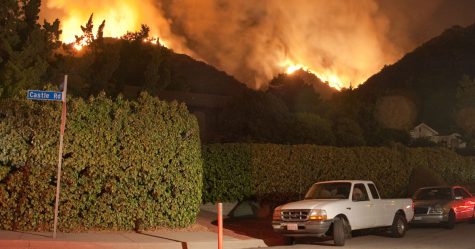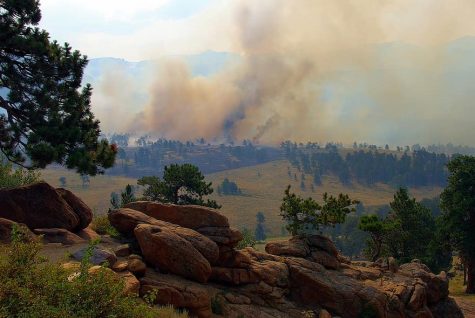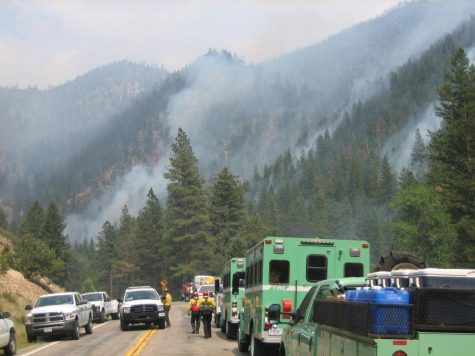Record-Breaking Wildfires Ravage Colorado
Fires of an unprecedented size are spreading throughout the state, endangering people, property, and wildlife
As I was walking home a couple weeks ago, I was caught off guard by a thick smoke in the distance. It covered the usually stunning view of our mountains and made the air feel heavier than usual. Doing homework that night, I noticed another unusual sight: a blood red moon. Little did I know that something so magnificent was actually a sign of the worst wildfire in state history.

Sparked by lightning that struck sometime around late July, the Pine Gulch fire rapidly spread throughout Northwestern Colorado near the town of Fruita. The wildfire has officially engulfed 139,007 acres of land, as of September 4th. For reference, the third worst wildfire in our state’s history barely reached 100,00 acres. Officials were unable to contain the Pine Gulch fire in its early stages for several reasons. A combination of drought-stressed florae, unusually hot weather, and steep, mountainous terrain led to the fire spreading freely for weeks. Later on, severe winds further aided the fire’s sprawl across our Colorado woodlands. All of this culminated on the night of August 27, when the Pine Gulch officially became the largest fire our state has ever seen.
In addition to the Pine Gulch fire, three other fires -the Grizzly Creek, Cameron Peak, and Williams Fork- have been spreading throughout the mountains. Combined, these three have burnt through roughly 70,000 acres of land. All three are situated near important forests, such as Arapaho National Forest. While these fires have been less severe, they have used up resources and firefighters that would have otherwise been used to fight the Pine Gulch fire.

Many of us are left wondering why fires this year are so destructive. September and October are usually the worst months for wildfires, and yet August has already seen record-breaking flames. The answer to this question lies in the worsening condition of our climate. With temperatures rising at an alarming rate and a shortage of water and snowpack, climate change has given fires perfect conditions to start and spread. Dry, open land is exactly the environment that bred the Pine Gulch fire and several others this fall.
Fortunately, at the time of reporting, there have been zero recorded civilian or firefighter deaths. Property damage has also been relatively low. So far, only one residence and four minor structures have been reported as destroyed by fire activity. The real tragedy of these fires is both the cost and damage to wildlife. Our state is most likely more concerned with the former, so we will focus on that first.
$77 million is the price tag on these fires so far, and it will likely increase in the coming weeks since none of these blazes have been sufficiently dealt with. This cost is largely due to the high pricing of equipment. Firefighters make use of several tools, such as aircraft, safety equipment, digging tools, medical supplies, and fire retardant. Most of these items can be very expensive, especially when they are in high demand.
This demand stems from the fact that our state is not alone in having to deal with severe fires. Several other states, including California and Montana, are dealing with this exact same problem. In fact, California’s fires are setting records in land consumption in the same way the Pine Gulch is. With valuable resources and firefighters spread out across the country, it’s becoming more expensive to deal with fires.

One cost many overlook is the amount of money it takes to rehabilitate wildlife destroyed by these flames. It takes a significant effort to restore our forests and wildlife, so experts truly have no idea how much these fires will end up costing the state.
Speaking of wildlife restoration, our native flora and fauna are especially affected by these fires, far more than us. Flames and destruction have spread to several of our national forests and parks. Due to being in the vicinity of one of four fires, places like Arapaho National Forest, Rocky Mountain National Park, and White River National Forest are all in danger. These forests and parks hold beautiful wildlife, some of which are only found in Colorado. From cougars and bears to pine trees and blue spruces, a large group of animals and plants are in danger.
The Pine Gulch, along with other fires, have been so severe that they have affected our own community, almost 130 miles away from the nearest fire. While smoke wasn’t that severe in itself, it still was notably present in Aurora and Centennial. As an asthmatic, it was personally harder to breathe when I was outside for extended periods of time.
These fires have created warning signs and spread them for miles; a blood red moon, ash falling from the sky, smog surrounding us on all sides. Having seen these red flags, it is important for our community to take note and support the fight against these flames.

Demir Mikulin is a sophomore here at Eaglecrest and this is his first year on staff! He prefers the written content side of advanced media, and loves to...





